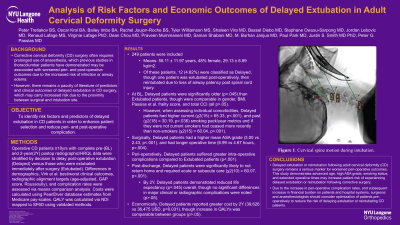Analysis of Risk Factors and Economic Outcomes of Delayed Extubation in Adult Cervical Deformity Surgery
Friday, April 21, 2023


Jamshaid M. Mir, MD
Research Fellow
NYU Langone Medical Center
Paterson, NJ, US
ePoster Presenter(s)
Introduction: There remains a paucity of literature of predictors and clinical outcomes of delayed extubation in cervical deformity (CD) surgery, which may carry increased risk due to the proximity between surgical and intubation site.
Methods: Operative CD patients ≥18yrs with complete pre-(BL) and 2-year(2Y) postop radiographic/HRQL data were stratified by delayed post-operative extubation (Delayed) vs. extubated immediately post-op (Extubated). Differences in clinical outcomes, radiographic realignment, and complication rates were assessed via means comparison. Costs were calculated using PearlDiver database estimates from Medicare pay-scales. QALY was calculated via NDI mapped to SF6D using validated methods.
Results: 249 patients were included (58.11±11.97 years, 48% F, 29.13±6.89 kg/m2. 12 patients (4.82%) were classified as Delayed. At BL, Delayed patients were significantly older (p=.045), though comparable in gender, BMI, Passias et al. frailty score, and CCI (all p>.05). Assessing individual comorbidities, Delayed patients had higher current (p < .001), and past (p=.036) smoking pack/years. Surgically, Delayed patients had a higher ASA grades (p < .001) and longer operative time (p=.004). Delayed patients suffered more intra-operative complications compared to Extubated patients (p < .001). Post-discharge, Delayed patients were more likely to require acute or subacute care (p < .001). By 2Y, Delayed patients demonstrated reduced life expectancy (p=.045), though no significant differences in major clinical or radiographic complications were identified (p>.05). Economically, Delayed patients had greater cost by 2Y (p=0.031), though the increase in QALYs was comparable between groups (p>.05).
Conclusion : This study demonstrates that advanced age, high ASA grade, smoking status, and extended operative time may increase patient risk of experiencing delayed extubation following cervical deformity corrective surgery. Due to the increase in peri-operative complication rates and the high associated financial burden on patients and hospital systems, surgeons and anaesthesiologists should consider optimization of patients pre-operatively to reduce the risk of delaying extubation in CD patients.
Methods: Operative CD patients ≥18yrs with complete pre-(BL) and 2-year(2Y) postop radiographic/HRQL data were stratified by delayed post-operative extubation (Delayed) vs. extubated immediately post-op (Extubated). Differences in clinical outcomes, radiographic realignment, and complication rates were assessed via means comparison. Costs were calculated using PearlDiver database estimates from Medicare pay-scales. QALY was calculated via NDI mapped to SF6D using validated methods.
Results: 249 patients were included (58.11±11.97 years, 48% F, 29.13±6.89 kg/m2. 12 patients (4.82%) were classified as Delayed. At BL, Delayed patients were significantly older (p=.045), though comparable in gender, BMI, Passias et al. frailty score, and CCI (all p>.05). Assessing individual comorbidities, Delayed patients had higher current (p < .001), and past (p=.036) smoking pack/years. Surgically, Delayed patients had a higher ASA grades (p < .001) and longer operative time (p=.004). Delayed patients suffered more intra-operative complications compared to Extubated patients (p < .001). Post-discharge, Delayed patients were more likely to require acute or subacute care (p < .001). By 2Y, Delayed patients demonstrated reduced life expectancy (p=.045), though no significant differences in major clinical or radiographic complications were identified (p>.05). Economically, Delayed patients had greater cost by 2Y (p=0.031), though the increase in QALYs was comparable between groups (p>.05).
Conclusion : This study demonstrates that advanced age, high ASA grade, smoking status, and extended operative time may increase patient risk of experiencing delayed extubation following cervical deformity corrective surgery. Due to the increase in peri-operative complication rates and the high associated financial burden on patients and hospital systems, surgeons and anaesthesiologists should consider optimization of patients pre-operatively to reduce the risk of delaying extubation in CD patients.
